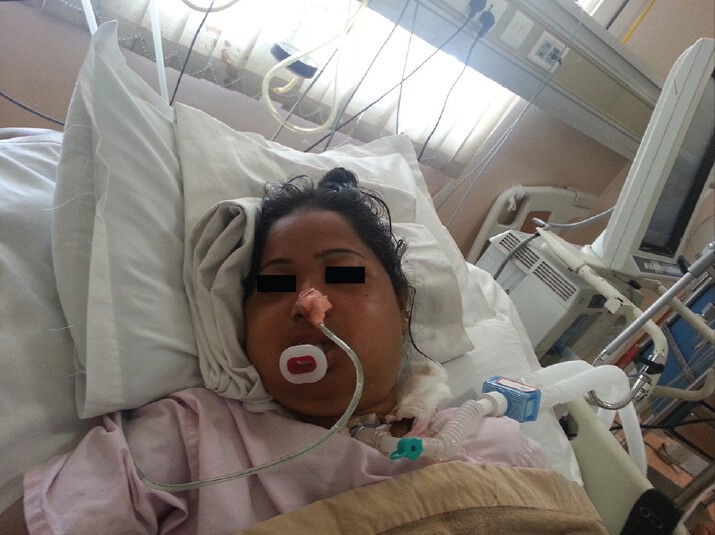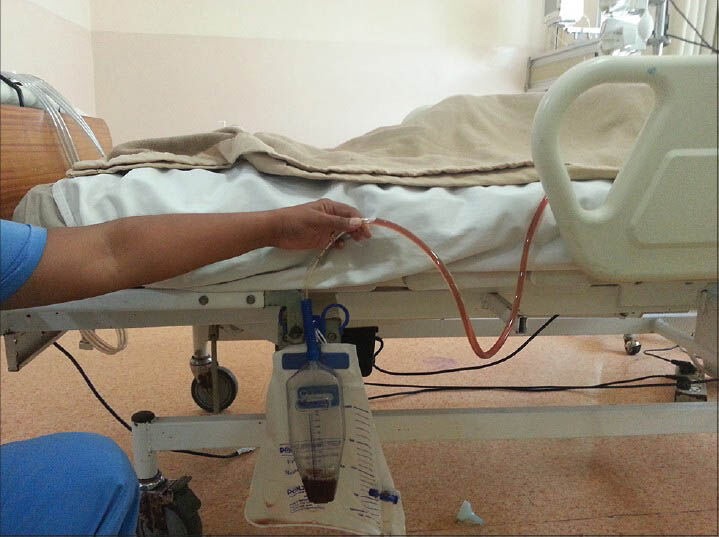Abstract
A 19-year-old female patient presented with alleged history of hair dye “Super Vasmol 33” intake. She presented with cervicofacial edema with upper airway obstruction. Although patient was being managed for airway obstruction, she developed cardiac arrest. Cardiac resuscitation could not be started at that point of time because managing airway was the priority in a patient who in hypoxic cardiac arrest. As soon as the airway was secured by emergency tracheostomy, cardiac resuscitation was initiated and the patient was successfully revived.
Keywords: Cervicofacial edema, emergency tracheostomy, hair dye poisoning, hypoxic cardiac arrest
Introduction
Poisoning due to hair dye is relatively rare in northern India and its ingestion as a means of deliberate self-harm is well-reported.[1,2,3,4,5,6,7] The compound in most hair dyes is paraphenylenediamine (PPD) in concentration ranging from 2 to 10%, respectively. PPD accelerates the dyeing process and thus used in hair dye formulation. The hair dye is extremely cheap and freely available, making it an attractive option for suicidal intent.
The effect of PPD when ingested is serious and includes cervicofacial edema, mucosal injury, respiratory distress, rhabdomyolysis, acute renal failure and myocardial injury.[2,3,4,5,6,7] The lethal dose of PPD is not known; estimate varies from 7 to 10 g. The characteristic chocolate brown color of urine could be confirmative evidence of hair dye poisoning in an individual with the poisoning of PPD. There is no antidote for PPD poisoning. If the poisoning is not recognized early, it has a very high mortality.
Case Report
A 19-year-old female patient presented in the emergency department 3 h after ingestion of hair dye “Super Vasmol 33.” Patient was immediately shifted to the intensive care unit (ICU) in view of cervicofacial swelling along with breathing difficulty. In ICU, after the initial examination endotracheal intubation was was found to be indicated, in view of rapidly increasing cervicofacial swelling and respiratory distress [Figure 1]. Patient was conscious but unable to speak. Endotracheal intubation was attempted but since the larynx could not be visualized was quickly aborted. Patient developed hypoxia. Mask ventilation was applied with Ambu bag, but ventilation was not adequate. Patient developed rapidly declining oxygen saturation and decreasing heart rate for which cricothyrotomy was attempted, but again because of the extensive cervical swelling the exact site could not be located. Hence, it was decided to go for emergency tracheostomy with the percutaneous method. Since ventilation could not be established, patient developed severe hypoxia, bradycardia, and finally asystole. At this stage, instead of starting cardiac resuscitation, it was decided to continue with tracheostomy as establishing the airway was the priority in hypoxic cardiorespiratory arrest. As soon as the guidewire was introduced into the trachea we started cardiac resuscitation within 2 minutes and the rest of the procedure of tracheostomy was continued along with cardiac resuscitation. In about 5 minutes time, spontaneous circulation was restored. The patient was put on the ventilator and nor adrenaline infusion was started.
Figure 1.

A case of hair dye poisoning with cervicofacial swelling
Her initial examination included cervicofacial swelling in the conscious patient who was not able to speak and was in respiratory distress. Her vital parameters were: Heart rate of 110/min regular, blood pressure 130/90, respiratory rate of 22/min and normal temperature. Initial lab results showed white blood counts of 12,000, platelet count 432,000, creatine phosphokinase (CPK) 3700, serum glutamate-oxaloacetate transaminase (SGOT) 76, serum glutamate-pyruvate transaminase (SGPT) 18, creatinine 0.7, international normalized ratio 1.04, troponin I 0.09, magnesium 2.3, calcium 7.03, lactate dehydrogenase 1854 and arterial blood gas analysis showed partial pressure of oxygen 141, of carbon dioxide 54 and pH of 6.93.
Patient was managed aggressively with IV fluids, mechanical ventilation and vasopressors. Subsequently the patient passed dark colored urine [Figure 2]. Her SGOT, SGPT and CPK were 6092 U/L, 1629 U/L, and 181,000 U/L, respectively on the on the 3rd day when the patient could be weaned off the ventilator. Her cervicofacial edema decreased considerably. Tracheostomy was closed on the 4th day and the patient was discharged.
Figure 2.

Dark brown color of urine
Discussion
Consumption of hair dye as a deliberate means of self-harm has been reported from different regions in India.[1,2,3,4,5,6,7] Rural, young poor women are the common subjects for whom this agent is inexpensive and easily available.[3,6,7,8] The brand Super Vasmol 33 is an emulsion containing 4 g of PPD in 100 ml costing only Rs. 35/-. Hair dyes could be perceived as “not bad enough to kill” by the vulnerable victims who may ingest it just with an intention of threatening the family. Unlike the other commonly used organophosphates, hair dye can be bought without raising suspicion of suicidal intentions, particularly in small villages with closed communities.
Paraphenylenediamine is the permanent black coloring agent applied with ammonia and hydrogen peroxide in hair dyeing.[3,4,6,9] It is also added to Henna (Lawsonia Alba) and used in the popular tattooing for its darkening effect.[4,8]
The most marked presentation as has been described of cervicofacial edema was evident in our patient at presentation. In such cases, the edema of face, neck and laryngeal region can be severe enough to cause respiratory distress, hypoxia, and necessitate an early and emergency intubation or tracheostomy, which is lifesaving.[3,4,5,6,7,8,9] In our patient, we continued with tracheostomy even after patient developed cardiac arrest as securing airway was the priority and starting cardiac compression could have led to delay in establishing the airway and restoring respiration as hypoxia had preceded the cardiac arrest.
Rhabdomyolysis can also be severe and if associated with high CPK can have an adverse outcome.[6] Our patient, however, responded to fluid resuscitation and improved without diuresis and dialysis in spite of very high levels of CPK. Though, serum creatinine values remained normal throughout the patient's course, acute renal failure is a reported complication of PPD poisoning.[3,5,8,9] It occurs due to a combination of hypovolemia, toxic injury and myoglobinuria.[5,6]
Conclusion
Hair dye (Super Vasmol 33) poisoning is emerging as a suicidal poison that is available quite freely and extensively hence awareness of its effects are important. Diagnosis requires a high index of suspicion, as the clinical features are quite distinctive. There is no specific antidote for PPD and treatment is supportive. Early recognition and treatment is vital for the management with special emphasis on airway control and prevention/treatment of renal failure.
Footnotes
Source of Support: Nil
Conflict of Interest: None declared.
References
- 1.Chugh KS, Malik GH, Singhal PC. Acute renal failure following paraphenylene diamine [hair dye] poisoning: Report of two cases. J Med. 1982;13:131–7. [PubMed] [Google Scholar]
- 2.Ashraf W, Dawling S, Farrow LJ. Systemic paraphenylenediamine (PPD) poisoning: A case report and review. Hum Exp Toxicol. 1994;13:167–70. doi: 10.1177/096032719401300305. [DOI] [PubMed] [Google Scholar]
- 3.Ram R, Swarnalatha G, Prasad N, Dakshinamurty KV. Paraphenylene diamine ingestion: An uncommon cause of acute renal failure. J Postgrad Med. 2007;53:181–2. doi: 10.4103/0022-3859.33860. [DOI] [PubMed] [Google Scholar]
- 4.Verma R, Tewari N, Jaiswal S, Rastogi V, Singh DK, Tiwari A. Fatal poisoning caused by oral ingestion of a hair dye. Internet J Emerg Intensive Care Med. 2008;11:1. [Google Scholar]
- 5.Sampathkumar K, Yesudas S. Hair dye poisoning and the developing world. J Emerg Trauma Shock. 2009;2:129–31. doi: 10.4103/0974-2700.50749. [DOI] [PMC free article] [PubMed] [Google Scholar]
- 6.Chrispal A, Begum A, Ramya I, Zachariah A. Hair dye poisoning: An emerging problem in the tropics: An experience from a tertiary care hospital in South India. Trop Doct. 2010;40:100–3. doi: 10.1258/td.2010.090367. [DOI] [PubMed] [Google Scholar]
- 7.Jain PK, Agarwal N, Kumar P, Sengar NS, Agarwal N, Akhtar A. Hair dye poisoning in Bundelkhand region (prospective analysis of hair dye poisoning cases presented in Department of Medicine, MLB Medical College, Jhansi) J Assoc Physicians India. 2011;59:415–9. [PubMed] [Google Scholar]
- 8.Filali A, Semlali I, Ottaviano V, Furnari C, Corradini D, Soulaymani R. A restrospective study of acute systemic poisoning of paraphenylenediamine (Occidental Takawt) in Morocco. Afr J Tradit Complement Altern Med. 2006;3:142–9. [Google Scholar]
- 9.Soni SS, Nagarik AP, Dinaker M, Adikey GK, Raman A. Systemic toxicity of paraphenylenediamine. Indian J Med Sci. 2009;63:164–6. [PubMed] [Google Scholar]


